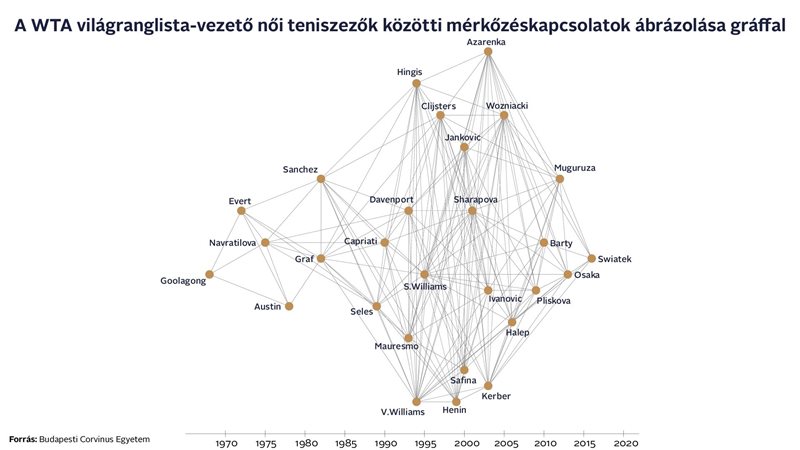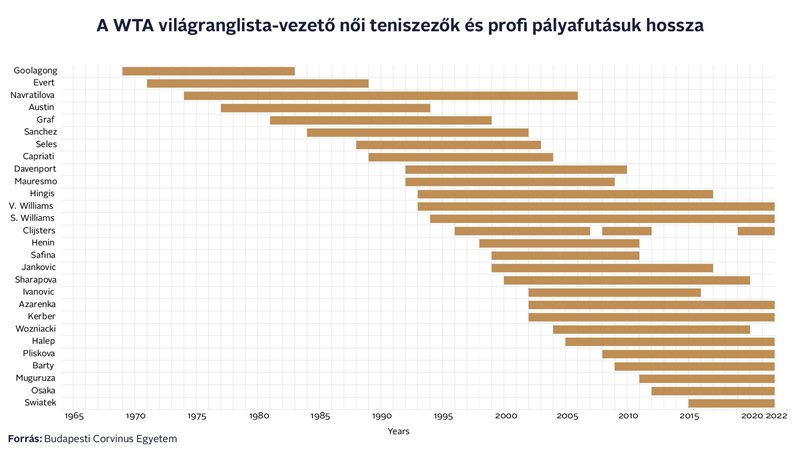Tennis rankings of all time compiled at Corvinus

This research used data from pairwise comparisons to determine rankings even among players who have never played each other. The results are also plotted in graphs, which opens up new possibilities for multicriteria decision-making.
Ranking the best in an individual sport, selecting the best person for a given position, determining the direction of development of an urban public transport system: how can you establish an absolute order between elements that cannot all be paired directly to produce meaningful results or there is no capacity for such an exercise? In decision analysis methodology, pairwise comparisons are often used to produce rankings, but there are often cases where there is no direct relationship between two or more elements.
The researchers from the Corvinus University of Budapest – József Temesi, Zsombor Szádoczki and Sándor Bozóki – used the example of the world’s top-ranked women tennis players between 1973 and 2022 to show how their performance can be compared even if they never played a match against each other, using their win-lose ratios. Around half of all possible matches between the 28 athletes did not happen, and around a tenth of the matches played had an equal win-loss ratio. In the study, the ranking of the latter was decided by the number of games won. The study has been published in the Journal of the Operational Research Society, using the database on the head-to-head results available on the website of the Women’s Tennis Association (WTA).
The results are in line with the experts’ opinions: the top three are Serena Williams, Steffi Graf and Martina Navratilova, followed by Martina Hingis, Kim Clijsters and Justine Henin. The order was not significantly affected by results in round robin tournaments (where player A beats B, B beats C but C beats A, e.g. Henin, Davenport and Venus Williams). You can see from the data that when arranged in a graph, they are connected and there is a path any two points. The choice of the estimation method that produces the ranking does not significantly affect the results.
“We did not weight separately either the type of court surface, or the period of a tennis player’s career in which a particular match took place, because these corrections would introduce a subjective factor,” said József Temesi, Professor Emeritus at the Corvinus Institute of Operations and Decision Sciences, and first author of the study. “However, matches can also be sorted according to the court surface, which could be the subject of a future study,” he added.
Some interesting facts from the data system
The Williams sisters competed against the highest number of players topping the world ranking lists, Monica Seles is 11th in the all-time ranking
Of the twenty-eight players, the Williams sisters played against the most, twenty-two players. In the sample, Goolagong had competitions with the fewest players, only three in number. There is a maximum distance of four games between any two players (this is between Goolagong and four youngsters, Osaka, Muguruza, Barty and Swiatek respectively), and this does not change if the Williams sisters with the most connections are excluded from the analysis.
Players are in a marginal position at the beginning and end of the 50-year period; however, we can find players who “connect” them, such as the Williams sisters or Sharapova. Navratilova could have been one of them, but despite her long career, she has only met 8 players of the other 27 (and in the second half of her career, she focused on doubles rather than singles).
“Based on the results, top tennis is surprisingly endogenous, with the best players often meeting each other. Even in our small sample, we can see that the ratio of number of matches in our database/number of matches in the entire career is the smallest for Swiatek (6%), and the largest for Serena Williams (25%).-said József Temesi.
Graph representation of match relations between the top WTA players

Top WTA players and the length of their professional careers
